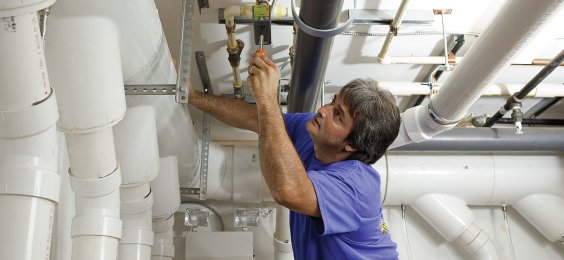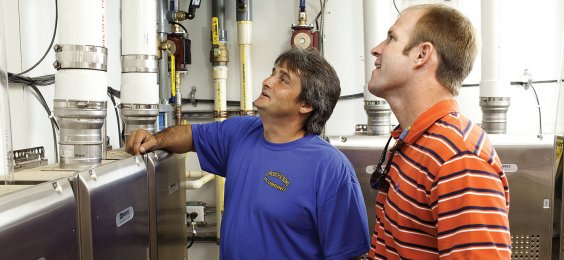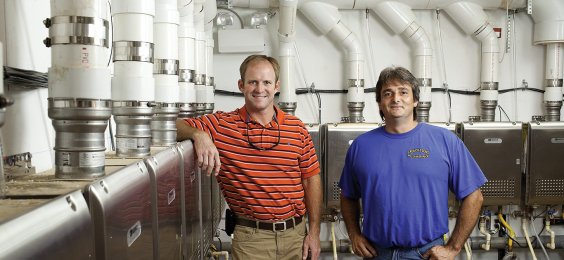Property Profile |
|
|---|---|
| Location | Residence Inn, Marriott |
| City | Florence, AL |
Noritz Installation |
|
|---|---|
| Location | 130-Room Hotel |
| Applications | NCC199-SV |
| Venting | Common Vent System |
Noritz Heater Profile |
|
|---|---|
| Noritz Model | NCC199-SV |
| Fuel Type | Natural Gas |
| Min. / Max. Btuh | 11,000 – 199,900 |
NCC199-SV Installation Images
Cramped Mechanical Room Spurs Switch to Multi-Unit Tankless Water Heating System for 130-Room Hotel Project
When the original boiler spec proves unworkable, hotel ownership switches to a 93%-efficient condensing tankless solution to save both space and fuel costs. With inputs up to 3.4 million BTU per hour, the 17-unit system uses innovative common-venting approach to minimize exterior wall penetrations.
FLORENCE, ALA. — Saving space is invariably one of the prime attractions in switching from a storage tank-type water heater to a tankless system. Most applications involve mounting these medicine-cabinet-sized appliances on an exterior wall, which frees up precious floor space for more productive uses. Even multiple-unit commercial systems, whether hung on the wall or placed into some sort of racking system in the middle of a room, tend to command substantially less space than a comparably sized tank-type system.
The space-saving advantages of tankless water heating recently came into critical play at a 130-room hotel renovation project in Florence, Alabama. The original specification for the Florence Residence Inn by Marriott called for a pair of 750-gallon, 750,000 BTU per hour (BTU/h) boilers, each measuring roughly five feet by 12 feet. The mechanical room where they were to be squeezed into could accommodate both pieces of equipment, but with just a few inches of clearance between each unit and the surrounding walls.
Contractor Anthony Crouch, owner of Crouch & Sons Plumbing LLC in Florence, reviewed the original specification with his plumbing distributor, the Tallman Company, and quickly concluded that the installation was all but unworkable.
“Anthony and I told the hotel owner that we could make it work — barely,” recalls Jason Veal, who works as a full-time outside salesperson for Tallman, also based in Florence. “But if one unit ever needed servicing, both would need to be pulled from the space, because there simply wasn’t enough room to work. That, in turn, would mean the entire hotel would have to go without hot water until maintenance was finished.”
Impossible predicament: To no one’s surprise, hotel owner Giri Yadla immediately dismissed the notion of going without hot water for any length of time: Were there no practical alternatives? Veal, whose company distributes tankless water heaters made by Noritz America, immediately saw a fit for tankless because of its space-saving benefits.
A multi-unit system would be required to meet all of the hotel’s hot-water needs, especially during peak periods, he and Crouch explained. These units are not only much smaller than the two specified boilers but because they would also wall-hung, there would also be more room for service work. Furthermore, if one unit had to be shut down, the others would still operate as usual. Guests would see no interruption in service.
The modularity of tankless technology met their customer’s baseline need for readily available hot water. But Veal and Crouch also stressed that, unlike a boiler, a tankless water heater doesn’t heat and re-heat water all day long, but only when responding to a specific demand.
Instead of using 1.5 million BTU to keep 1,500 gallons of water at a specified temperature 24/7/365 — as with the original spec — the tankless units would work in sequence, firing one by one as needed, to meet present requirements. Once those requirements were met, the units would turn down or off, minimizing energy consumption.
Yadla very much liked what he heard, both in terms of space savings and fuel savings, so the specification was changed and tankless was approved for the application. “We decided to go with a tankless unit because it is more efficient and a great energy-saver,” Yadla commented recently.
Adds hotel general manager Timothy Pritchett: “Using a tankless water heating system saves money. The new system will ensure that our visitors will always have hot water.”
Maximizing efficiency, minimizing cost: The new system involves 17 Noritz NCC199-SV condensing, gas-fired tankless water heaters: 12 supply the 130 guest rooms; the remaining five handle the dining area and the laundry room. Each has a thermal efficiency of 93 percent and a firing range of 11,000 BTU/h to 199,900 BTU/h. The latter calculates into an aggregate maximum input of nearly 3.4 million BTU/h with a turndown ratio of 309 to 1, allowing the system to comfortably handle both peak and light-demand periods with maximum efficiency and minimal cost.
“We expect each water heater to be delivering 4.6 gallons of hot water per minute in the winter, assuming a ground-water temperature of 50°F; and roughly 6.8 gpm in the summer, based on 65°F groundwater,” says Adam Brown, Noritz Southeast branch manager, whose operation worked with contractor Crouch and Noritz rep Tim Morales of Tim Morales & Associates on the design of the system.
While the limitations of the mechanical room created the opening for tankless on this project, its space constraints generated its own set of challenges for the design and installation team. Fitting seventeen, 24-inch x 18-inch, tankless water heaters into the 12-foot x 18-foot area was certainly doable with a bit of judicious space management. But these are gas-fired units, so they require venting to the outdoors. In simple one- and two-unit installations, each water heater typically has its own through-the-wall vent. But, as Crouch and Brown both note, hotel ownership were understandably less than thrilled by the idea of 17 separate vents protruding through the exterior wall of its new facility.
Once again, the team delivered an innovative, alternative solution, one that Noritz recently unveiled specifically for commercial installs: a fan-assisted, common vent system, whose components are made by Exhausto Inc. The Residence Inn project uses two such manifolds: one to remove all of the emissions from the units servicing the guest rooms; the second for the five units supplying the common areas and workspaces.
“The pressure through each manifold is maintained at a preset level by a modulating fan that is directed by a controller,” Brown explains. “The controller, in turn, monitors exhaust pressure through a sensor located at the end of the manifold run.”
Installation – finessing the space: The most prominent element of each venting system is the massive manifold pipe itself, measuring a hefty 10 inches in diameter. Given the dimensions of the surrounding space, including nine-foot ceilings and a 4-foot x 6-foot louvered fan for importing makeup air from outdoors, the Crouch installation team found itself coping with some fairly tight angles.
“The ceiling height was the most serious hurdle,” says Brown. “First, you’ve got the 10-inch PVC manifold and the two-foot-long water heater, plus an additional couple of feet of required clearances. Beneath the water heaters are the hot-water, cold-water and gas lines. Somehow, Anthony managed to fit all those elements into the available space, but another foot or two of ceiling height would have made things much easier.”
Indeed, the installers literally ran out of space on one of the units supplying the guest rooms. “A ten-by-four PVC wye is a pretty big fitting,” Veal explains. “When you try to get 12 of those on a single manifold run plus a 10-inch PVC elbow, the spacing gets pretty tight.”
So the installers compromised, removing the last water heater in the 12-unit line from the manifold and equipping it with its own 4-inch direct vent. Thus, the final through-the-wall tally came in at three terminations. As Veal notes, three punch-outs look a whole lot better to hotel management than 17.
Likewise, the overall footprint of the entire tankless installation, as compared with what might have been with the original boiler tandem. The tankless and common venting solutions proved so effective on this project, Yadla is now contemplating going with this approach on future hotel projects.
By convincing hotel management to switch from a pair of large gas boilers to a multiple-unit tankless water heating system, Crouch and Veal spared the facility potentially major maintenance problems — and a legion of unhappy hotel guests — while also enabling the owner to cut his ongoing fuel costs substantially. In addition, the innovative venting system recommended by Noritz made sense not only from an engineering perspective but also helped preserve the appearance of the hotel property.
“Because owners and managers stand to save so much on their gas bills, more and more commercial jobs will opt for tankless,” Crouch predicts. Of course, the use of tankless on the Residence Inn project was driven by the need for more space. “In that situation, we really had no choice but to take a different approach, because the original spec just wasn’t practical. Going tankless has worked out super.”
Because owners and managers stand to save so much on their gas bills, more and more commercial jobs will opt for tankless







